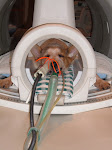Treatment:
Both medication and surgery are possible treatments for Hydrocephalus. Medical therapy may be palliative (ease symptoms, but not cure) and will help most patients. However, if the hydrocephalus is severe, then medication will probably not be effective long term and surgery may be required.
There are several different medications that may be prescribed. Medications that decrease CSF production in the brain are a key component of this treatment. Acetazolamide or methazolamide are carbonic anhydrase inhibitors that decrease CSF production and can be palliative for hydrocephalus. Omeprazole and prednisone are also known to decrease CSF production. Diuretics like furosemide help pull fluid from the brain as well as decreasing CSF production. Often, a combination of these medications may be used. If helpful, medical treatment may be continued long term, but special attention should be paid to possible medication side effects.
Surgery is recommended for patients with severe hydrocephalus. Placement of a ventriculoperitoneal shunt allows for continuous drainage of CSF, and is the treatment of choice in people. In general, the earlier a shunt is placed, the better the long term prognosis is for neurological recovery. The goal of CSF shunting is to halt disease progression and improve the neurologic status of the patient.
A shunt has several components: the ventricular catheter (placed in the ventricles of the brain where the CSF is held), the peritoneal catheter (drains into the abdominal cavity), and the valve in between. The valve prevents fluid from flowing backwards and prevents over-shunting of CSF. Some shunts may also have a port that can be used to collect CSF intermittently (when needed).
Complications:
Shunt surgery is considered to have a high success rate, but there is also a significant rate of complications after surgery - about 30%. Possible complications include infection of the shunt, which can ultimately lead to meningitis (infection of the coverings around the brain and spinal cord) or peritonitis (inflammation/infection of the abdominal cavity); obstruction of the shunt; or migration (movement) of the shunt. When these complications occur, they may be treated medically, but often, the shunt must be replaced.
In humans, causes for shunt failure include mechanical failure of the shunt, infection, and functional failure from over or under drainage. Mechanical failure and infections are most likely to occur within the first 6 months after shunt surgery.
It is important to schedule regular examinations with your pets neurologist to watch for signs of improvement or deterioration. Rapid deterioration of the patients neurologic status (i.e., mentation, respiration, postural reaction deficits) is suggestive of elevated intracranial pressure and shunt malfunction.
Depending on the severity of the underlying disease process, the prognosis of patients that have undergone ventriculoperitoneal shunting is guarded to fair. In severe cases of hydrocephalus, neurologic improvement may be minimal. A realistic expectation is improvement of clinical signs but not complete resolution of neurologic deficits.
"Baby Love" did not gain sight or become a "normal" dog after the shunt was installed. But she was better in many aspects and her quality of life was greatly improved. Dr. Ducote and her staff were always up front about risks and possibilities as well as giving me a realistic idea of what to expect in the way of progress. Ask your neurologist lots of questions and make sure you are aware of what to expect. As mentioned above the shunt is not a reversal of this condition or cure it is however the best treatment for the symptoms of severe Hydrocephalus.
Information and resources about Hydrocephalus in pets
Pages
Pages
Contact Us
What to expect - Surgery
HYDROCEPHALUS IN PETS
BABY LOVE'S STORY
This is Baby Love's Life:
Birth

Baby Love was born in an animal shelter on July 7, 2007, her mom Amber was a stray who had been picked up a few days before. Baby Love was one of 9 puppies.
Different

Soon we realized she was different from the others. She was always by herself and not in the puppy huddle. So we started bottle feeding her and keeping a careful eye on her.
Going Home

At 4 weeks old she contracted both ringworm and kennel cough so I took her home and nursed her back to health. She was also physically and mentally behind the other puppies.
Blossoming

Though still sick, Baby Love thrived in her new enviroment. She had lots of affection and constant feedings. She blossomed, and a day or two after arriving at the house she was a new dog. She was happy and ready to start exploring the world.
Blindness

She took on the world one bunny hop at a time. I soon realized there was more wrong with Baby Love than we thought. She was blind!
Growing

Baby Love continued to grow, and after some research we discovered that she most likely had Hydrocephalus (fluid on the brain). There was a newspaer article written about her, and we started a fundraising drive for tests and treatment.
MRI

The day came and she had an MRI, which confirmed she had Hydrocephalus.
Surgery

Thanks to donations, Baby Love had surgery to try and correct her condition.
Success

The sugery was a success, though she did not gain sight she became a much happier dog, her motor skills were great and she had a thirst for life I'd never seen before.
Everyday Life

She loved to run, bunny hop, explore and find mischief.
Summer

Summer came around again and she was the best she'd ever been. She loved the other dogs and our cuddle time
Signs of Trouble

Around Memorial Day of 2008 she started having some issues. We soon discovered her shunt which was installed in her body to assist with the excess fluid development - had stopped working.
The End

Thanks to donations she had a second surgery. She did not recover well, and a week later she passed away. Baby Love had sponsors and well wishers from all over the world who followed her story. I thank them all!
No comments:
Post a Comment